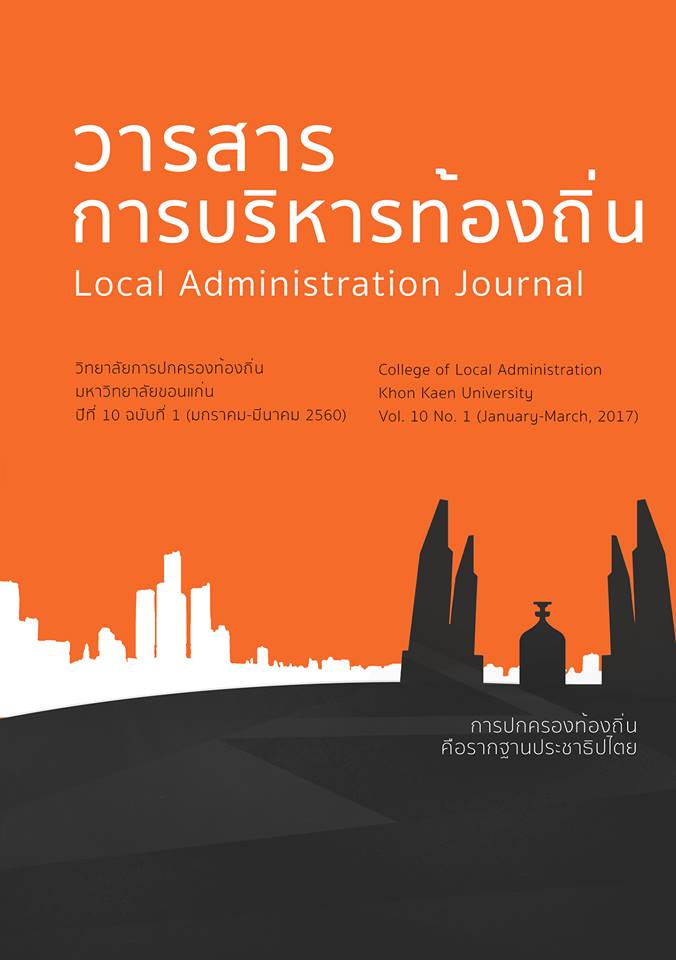การจัดการป่าชุมชนแบบมีส่วนร่วมโดยการเทียบเคียงต้นแบบเพื่อการจัดการป่าชุมชนที่ยั่งยืน ของตำบลนาชุมแสง อำเภอภูเวียง จังหวัดขอนแก่น
Keywords:
การจัดการป่าชุมชน, กระบวนคิด, วิถีชุมชน, การเทียบเคียง, Community forest Management, Comparative Study, Thought Process, Community Way of LifeAbstract
การวิจัยนี้มีวัตถุประสงค์เพื่อถอดบทเรียนการจัดการป่าชุมชนของบ้านทาป่าเปาซึ่งเป็นต้นแบบระดับประเทศ โดยทำการเทียบเคียงเพื่อนำปรับปรุงในการจัดการป่าชุมชนตำบลนาชุมแสงให้ยั่งยืน
การวิจัยพบว่า การจัดการป่าชุมชนของบ้านทาป่าเปาที่เป็นต้นแบบของประเทศไทยมีกระบวนการจากการโดยเปิดเวทีประชาคมค้นหาปัญหาค้นหาตนเองร่วมกัน แล้วนำเอาวัฒนธรรม ภูมิปัญญา ความเชื่อ ศรัทธาทางศาสนามาแก้ไขปัญหา จนเกิดการตั้งกรรมการป่าตั้งกฎการใช้ป่าร่วมกัน โดยมีชุมชนเป็นหลักจนเกิดผลสำเร็จ และการค้นพบกระบวนการการจัดการป่าของตำบลนาชุมแสง นั้นเริ่มจากผู้นำรวมตัวกันแล้วเปิดเวทีประชาคม ปรับกระบวนคิดตามวิถีชุมชน โดยนำเอาศรัทธาความเชื่อด้านศาสนามาเป็นหลักยึด มีพิธีกรรมการบวชป่า ตั้งกฎระเบียบการใช้ป่า
เมื่อเปรียบเทียบกับต้นแบบแล้วพบว่า กระบวนการส่วนมากคล้ายกันแต่มีข้อแตกต่างเพียง ไม่กี่ประเด็น เช่น คณะกรรมการของนาชุมแสงส่วนมากมาจากผู้นำ บ้านทาป่าเปามาจากคนในชุมชนเลือกกันเอง หลังเปรียบเทียบแล้วนำมาปรับให้เป็นแนวทางในการจัดการป่าชุมชนของนาชุมแสงเพื่อให้เกิดความต่อเนื่องและยั่งยืนนั้น ได้ตั้งกลุ่มจิตอาสาซึ่งเป็นเยาวชนเป็นรุ่นๆ ตั้งกลุ่มองค์กรในตำบล พร้อมองค์กรของรัฐ ที่อยู่ทั้งในและนอกพื้นที่ทำข้อตกลงร่วมกันเกี่ยวกับการใช้ป่าชุมชน ตั้งกฏิกาการใช้ป่าร่วมกันตั้งกองทุนป่า มีพระสงฆ์เป็นแกนนำในการบวชป่าทุกปีโดยมีกุศโลบายที่ว่า บวชร่วมใจ รักษาป่าเดิม ปลูกเพิ่มป่าใหม่ เพื่ออนาคตป่าชุมชนตำบลนาชุมแสงจะอยู่คู่ชุมชนอย่างยั่งยืน
Participatory Community Forest Management: A Comparative Study of Models for Sustainable Community Forest Management in Tambon Nachumsaeng, Phuwiang District, Khon Kaen Province
This research aimed to study participatory community forest management by conducting a comparative study of models for sustainable community forest management among villages in Tambon Nachumsaeng, Phuwiang District, Khon Kaen Province.
Findings show that the villages in Tambon Nachumsaeng convene public forums to identify problems themselves through a participatory process. Next, the communities apply traditional culture, wisdom, beliefs, and spiritual principles to address the challenges. The communities have formalized this process by appointing “community forest committees” comprised of local residents to define rules on shared use of the forest. This process was spearheaded by the community leaders in Tambon Chumsaeng. The process has been successful because it is based on shared religious beliefs, to the extent that the communities conduct “tree ordination ceremonies.”
When comparing the villages in Tambon Chumsaeng in implementing community forest management, there are only slight differences among sites. For example, most of the members of the Na Chumsaeng Village forest committee members are community leaders, while the committee members in Ban Tha Pa Pao Village are elected by the community residents. The experience of these model communities is synthesized to produce guidelines for sustainable community forest management. Groups of forest conservation volunteers have been appointed, including youth and other age groups, and these groups link with the relevant government agencies. They have negotiated agreements about the limitations in use of the community forest. Funds have been created for forest preservation, and Buddhist monks perform the annual tree ordination ceremonies. The strategy of the Tambon is summed up in the motto: Preserve the original forest and plant new forest for the everlasting future of the community forest of Chumsaeng.
Downloads
Published
How to Cite
Issue
Section
License
The copyright of all articles published in the Local Administration Journalis owned by the College of Local Administration, Khon Kaen University.



